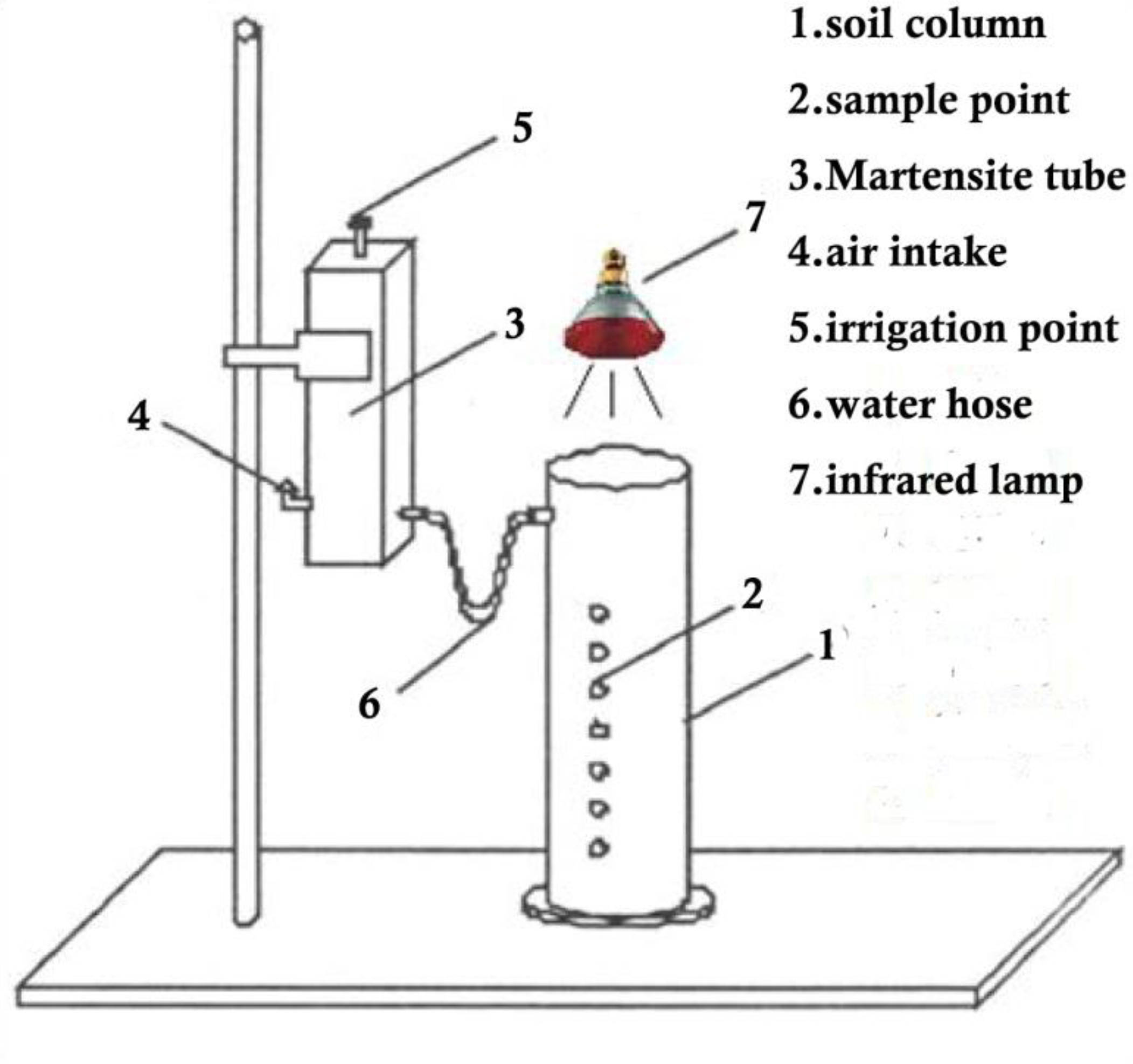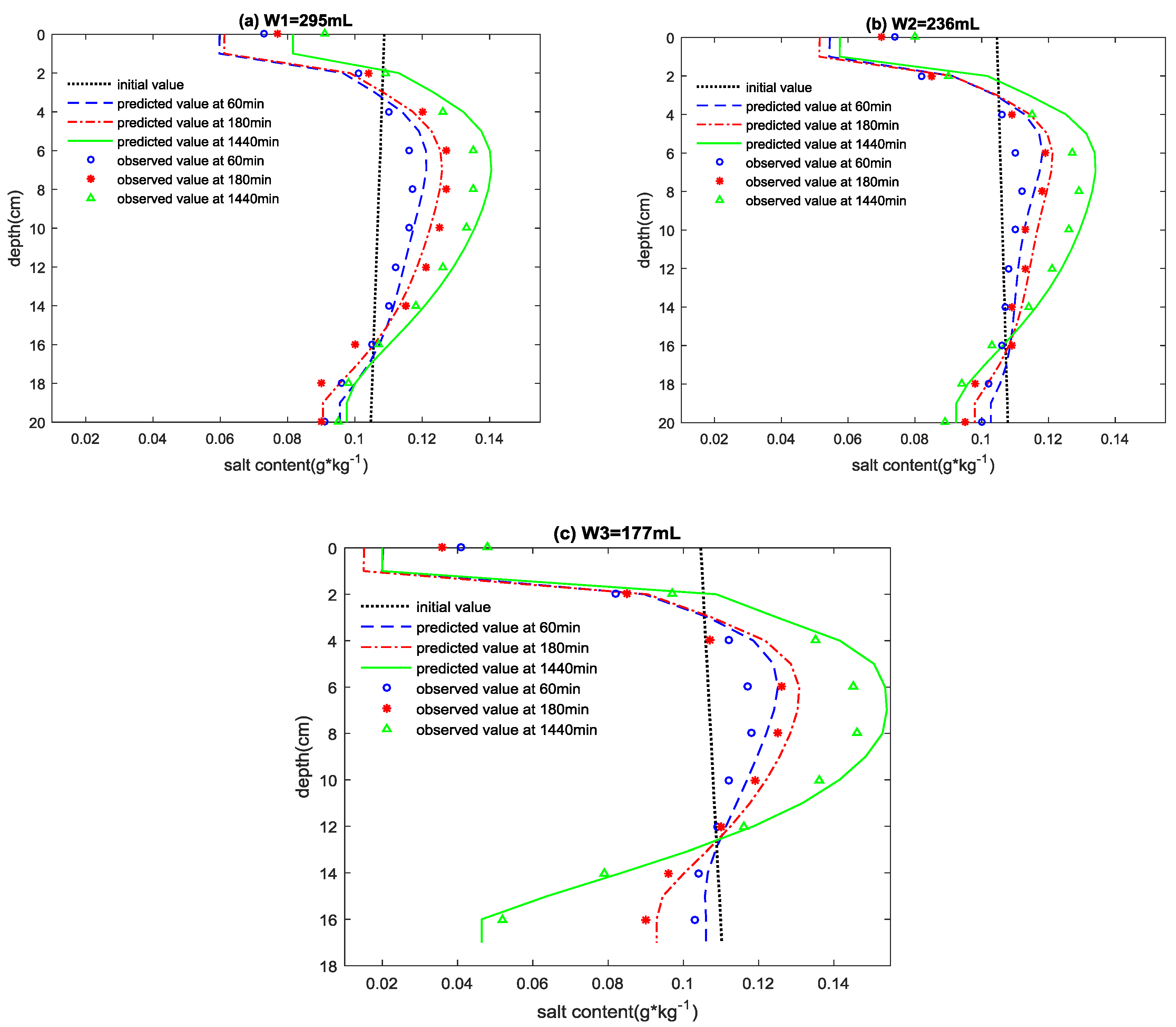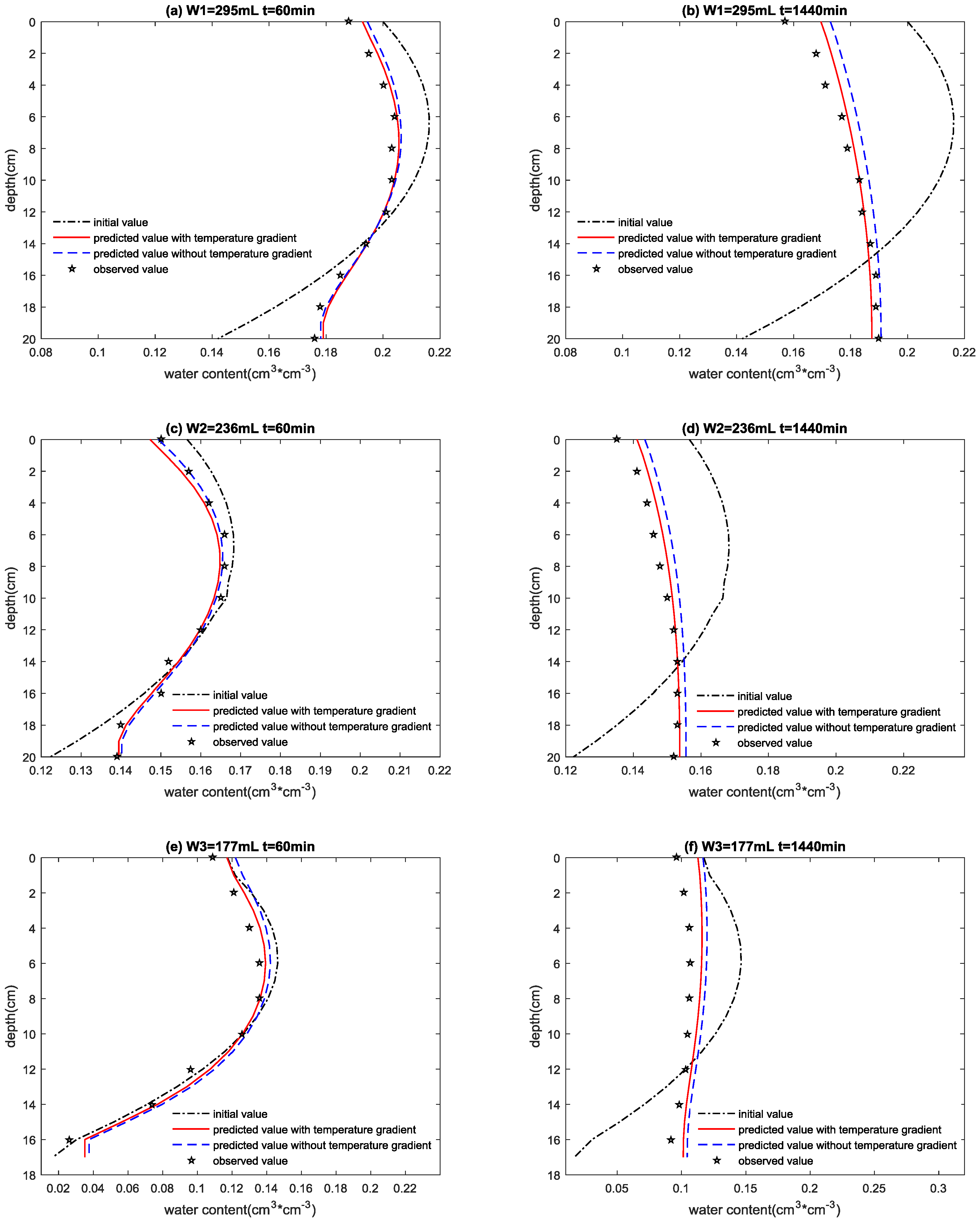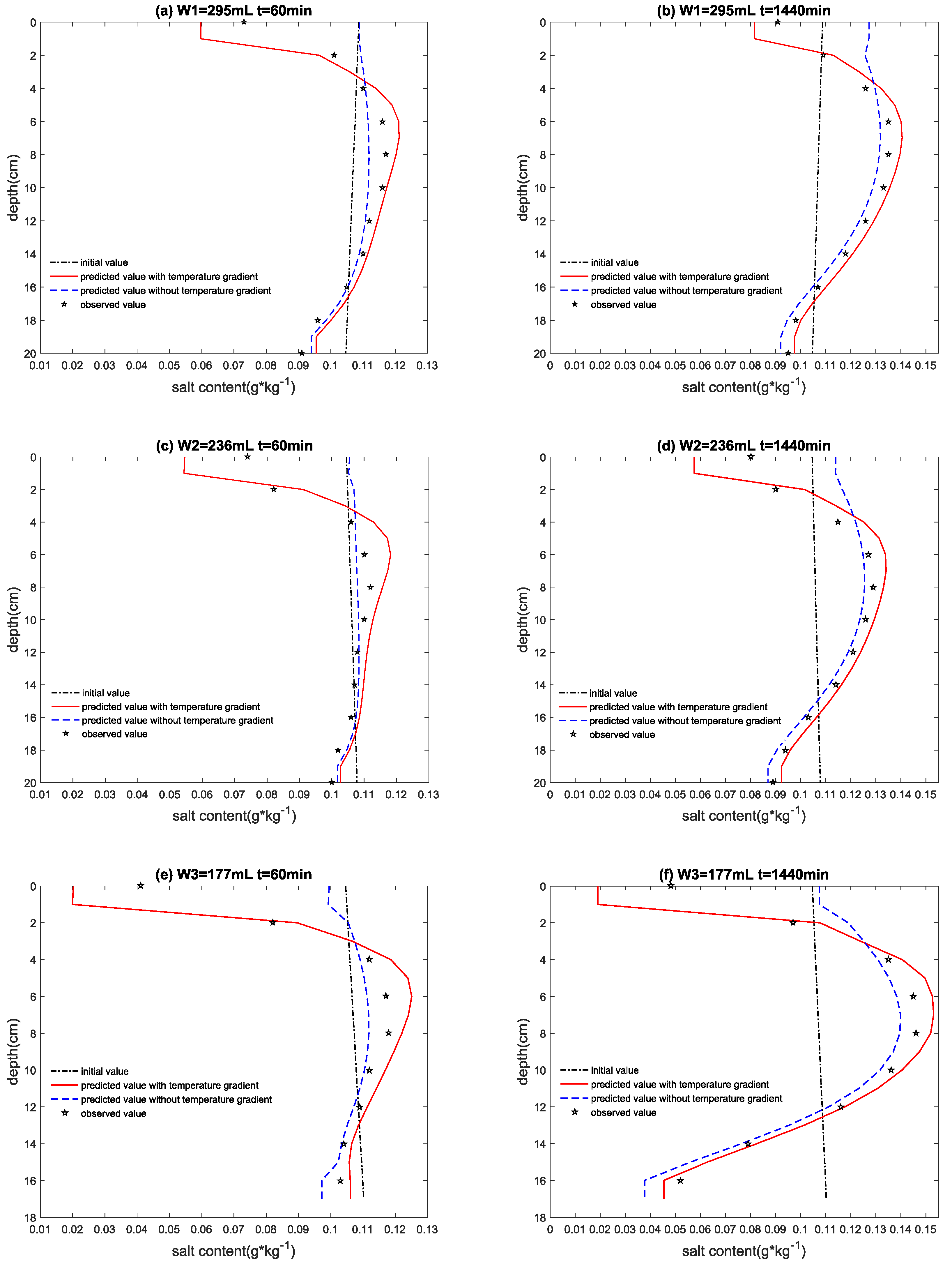An Investigation into the Effects of Temperature Gradient on the Soil Water–Salt Transfer with Evaporation
Abstract
:1. Introduction
2. Materials and Methods
3. Methods
3.1. Description of the Soil Water–Salt Model with Thermal Gradient
3.1.1. Water Movement Equation
3.1.2. Heat Flux Equation of Soil
3.1.3. Salt Solution Migration Equation of Soil
3.1.4. Initial and Boundary Conditions
3.2. Description of the Traditional Water–Salt Model Without Thermal Gradient
3.2.1. The Governing Equations
3.2.2. Initial and Boundary Conditions
3.3. Determination of Model Parameters
3.3.1. Determination of the Parameters for Soil Water Movement
3.3.2. Determination of the Parameters for Soil Heat Transfer
3.3.3. Determination of the Parameters for Soil Salt Solution Migration
3.4. Modeling Strategy
3.4.1. Calibration
3.4.2. Validation/Prediction
4. Results and Discussion
4.1. Simulation Results and Analysis
4.2. Error Analysis of Simulated and Observed values
4.3. Sensitivity Analysis
5. Conclusions
Acknowledgments
Author Contributions
Conflicts of Interest
References
- Feng, D.; Zhang, J.P.; Cao, C.Y.; Sun, J.S.; Shao, L.W.; Li, F.S.; Dang, H.K.; Sun, C.T. Soil salt accumulation and crop yield under long-term irrigation with saline water. J. Irrig. Drain. Eng. 2015, 141. [Google Scholar] [CrossRef]
- Wang, W.G.; Wang, X.G.; Shen, R.K.; Yang, S.Q.; Hu, W.M. Progress of research on light salt water irrigation. J. Water Sav. Irrig. 2003, 2, 9–11. [Google Scholar]
- Beltarn, J.M. Irrigation with Saline water: Benefits and environment impact. Agric. Water Manag. 1999, 40, 183–194. [Google Scholar] [CrossRef]
- Wang, Q.J.; Shan, Y.Y. Review of research development on water and soil regulation with brackish water irrigation. Trans. Chin. Soc. Agric. Mach. 2015, 12, 117–126. [Google Scholar] [CrossRef]
- Wang, R.S.; Kang, Y.H.; Wan, S.Q.; Hu, W.; Liu, S.P.; Jiang, S.F.; Liu, S.H. Influence of different amounts of irrigation water on salt leaching and cotton growth under drip irrigation in an arid and saline area. Agri. Water Manag. 2012, 110, 109–117. [Google Scholar] [CrossRef]
- Dutt, G.R.; Pennington, D.A.; Turner, F.J. Irrigation as a solution to salinity problems of river basins. In Salinity in Watercourses and Reservoirs; Ann Arbor Science: Salt Lake City, UT, USA, 1984; pp. 465–472. [Google Scholar]
- Liu, B.C.; Liu, W.; Li, Q.L. Numerical simulation of salt, moisture and heat transport in porous soil. J. Huazhong Univ. Sci. Technol. 2006, 34, 14–16. [Google Scholar]
- De Vries, D.A. Simultaneous transfer of heat and moisture in porous media. Trans. Am. Geophys. Union. 1958, 39, 909–916. [Google Scholar] [CrossRef]
- Kelleners, T.J.; Koonce, J.; Shillito, R.; Dijkema, J.; Berli, M.; Young, M.H.; Frank, J.M.; Massman, W.J. Numerical modeling of coupled water flow and heat transport in soil and snow. Soil Sci. Soc. Am. J. 2015, 2, 247–263. [Google Scholar] [CrossRef]
- Zhang, M.L.; Wen, Z.; Xue, K.; Chen, L.Z.; Li, D.S. A coupled model for liquid water, water vapor, and heat transport of saturated-unsaturated soil in cold regions: model formulation and verification. Environ. Earth Sci. 2016, 75, 701. [Google Scholar] [CrossRef]
- Elzeftawy, A. Modeling the Transport of Heat, Water, and Solute in Unsaturated Soil and Earth Materials; ASAE Publication: Washington, DC, USA, 1980; pp. 234–245. [Google Scholar]
- Yang, S.X. Soil Heat Flux and the Basic Equation. In Soil Water Dynamics; Lei, Z.D., Yang, S.X., Sen, S.C., Eds.; Tsinghua University Press: Beijing, China, 1998; pp. 67–76. [Google Scholar]
- Chen, L.J.; Feng, Q.; Wang, Y.; Yu, T.F. Water and salt movement under saline water irrigation in soil with clay interlayer. Trans. CSAE 2012, 28, 44–51. [Google Scholar]
- Bi, Y.J.; Wang, Q.J.; Xue, J. Effect of saline water for increasing soil water before sowing on helianthus growth and saline distributional characteristics of soil. Trans. CSAE 2009, 25, 39–44. [Google Scholar]
- Lei, T.W.; Xiao, J.; Wang, J.P. Experimental investigation on the effects of saline water drip irrigation on water use efficiency and quality of watermelons grown in saline soils. J. Hydraul. Eng. 2003, 34, 85–89. [Google Scholar]
- Wan, S.Q.; Kang, Y.H.; Wang, D. Effects of saline water on cucumber yield and irrigation water use efficiency under drip irrigation. Trans. CSAE 2007, 23, 30–35. [Google Scholar]
- Ju, L.; Wang, Q.J.; Wang, L.F. Effects of irrigation amounts on yield of wheat and distribution characteristics of soil water-salt in semi-arid region. Trans. CSAE 2007, 23, 86–90. [Google Scholar]
- Zhang, J.P.; Feng, D.; Zheng, C.L.; Sun, C.T.; Sun, J.S.; Gao, Y. Effects of saline irrigation on soil water-heat-salt variation and cotton yield and quality. Chin. Soc. Agric. Mach. 2014, 45, 161–167. [Google Scholar] [CrossRef]
- Zhang, J.P.; Cao, C.Y.; Feng, L.; Sun, J.S.; Li, K.J.; Liu, H. Effects of different planting patterns on cotton yield and soil water-salt under brackish water irrigation before sowing. Trans. Chin. Soc. Agric. Mach. 2013, 44, 97–102. [Google Scholar]
- Ren, R.; Ma, J.J.; Cheng, Q.Y.; Zheng, L.J.; Guo, X.H.; Sun, X.H. Modeling coupled water and heat transport in the root zone of winter wheat under non-isothermal conditions. Water 2017, 9, 290. [Google Scholar] [CrossRef]
- Horton, R.E. An approach toward a physical interpretation of infiltration capacity. Soil Sci. Soc. Am. J. 1941, 5, 399–417. [Google Scholar] [CrossRef]
- Philip, J.R. The theory of infiltration: 1. The infiltration equation and its capacity. Soil Sci. 1957, 83, 345–357. [Google Scholar] [CrossRef]
- Wang, W.G.; Wang, X.G.; Shen, R.K. Experimental research on saline-water irrigation in Hetao Irrigation District. Trans. CSAE 2004, 20, 92–96. [Google Scholar]
- Yang, S.Q.; Ding, X.H.; Jia, J.F. Light-saline water use pattern in saline soil environment. J. Hydraul. Eng. 2011, 42, 490–498. [Google Scholar]
- Chen, Y.M.; Wang, S.L.; Gao, Z.Y. Effect of irrigation water mineralization on soil salinity based on Salt Mod model. J. Irrig. Drain. 2012, 31, 11–16. [Google Scholar]
- Phogat, V.; Yadav, A.K.; Malik, R.S. Simulation of salt and water movement and estimation of water productivity of rice crop irrigated with saline water. Paddy Water Environ. 2010, 8, 333–346. [Google Scholar] [CrossRef]
- Forkutsa, I.; Sommer, R.; Shirokova, Y.I. Modeling irrigation cotton with shallow groundwater in the Aral Sea Basin of Uzbekistan: I. water dynamics. Irrig. Sci. 2009, 27, 331–346. [Google Scholar] [CrossRef]
- Li, X.W.; Jin, M.G.; Yuan, J.J. Evaluation of soil salts leaching in cotton field after mulched drip irrigation with brackish water by freshwater flooding. J. Hydraul. Eng. 2004, 45, 1091–1098. [Google Scholar] [CrossRef]
- Van Genuchten, M.T. A Closed-form equation for Predicting the Hydraulic conductivity of unsaturated soil. Soil Sci. Soc. Am. J. 1980, 44, 892–898. [Google Scholar] [CrossRef]
- Philip, J.R. Evaporation, moisture and heat fields in the soil. J. Meteorol. 1957, 14, 354–368. [Google Scholar] [CrossRef]
- Ministry of water resources of the people’s Republic of China. Irrigation Experiment Standard; China Water Power Press: Beijing, China, 2015; pp. 68–69.
- Li, Y.; Shao, M.A.; Wang, W.Y.; Wang, Q.J.; Zhang, J.F.; Lai, J.B. Influence of soil textures on the thermal properties. Trans. CSAE 2003, 4, 62–65. [Google Scholar]
- Zuo, Q. The measurement and Calculation of Hydrodynamic Dispersion Coefficient. In Soil Solute Transport; Li, Y.Z., Li, B.G., Eds.; Science Press: Beijing, China, 1998; pp. 285–290. [Google Scholar]
- Nassar, I.N.; Robert, H. Water transport in unsaturated nonisothermal salty soil I, II. Soil Sci. Soc. Am. J. 1989, 53, 1323–1337. [Google Scholar] [CrossRef]
- Guo, X.H.; Sun, X.H.; Ma, J.J. Parametric estimation of the van Genuchten’s equation equation based on hybrid genetic algorithm. Adv. Water Sci. 2009, 5, 677–682. [Google Scholar] [CrossRef]
- Milly, O.C.D. A simulation analysis of thermal effects on evaporation from soil. Water Resour. Res. 1984, 20, 1087–1098. [Google Scholar] [CrossRef]
- Wu, C.L.; Chau, K.W.; Huang, J.S. Modelling coupled water and heat transport in a soil-mulch-plant-atmosphere continuum (SMPAC) system. Appl. Math. Model. 2007, 31, 152–169. [Google Scholar] [CrossRef]
- Zhao, D.; Li, Y.; Feng, H. Dynamics of soil water evaporation from soil mulched with sand-gravels in stripe. Acta Pedol. Sin. 2015, 52, 1058–1068. [Google Scholar] [CrossRef]
- Simunek, J.; van Genuchten, M.T.; Sejna, M. Development and applications of the HYDRUS and STANMOD software packages and related codes. Vadose Zone J. 2008, 7, 587–600. [Google Scholar] [CrossRef]
- Ouedraogo, F.; Cherblanc, F.; Naon, B.; Benet, J.-C. Water transfer in soil at low water content. Is the local equilibrium assumption still appropriate? J. Hydrol. 2013, 492, 117–124. [Google Scholar] [CrossRef]
- Tang, C.S.; Shi, B.; Gu, K. Experimental investigation on evaporation process of water in soil during drying. J. Eng. Geol. 2011, 19, 875–881. [Google Scholar]
- Tang, C.S.; Shi, B.; Liu, C.; Gao, L.; Inyang, H. Experimental investigation of the desiccation cracking behavior of soil layers during drying. J. Mater. Civ. Eng. 2011, 23, 873–878. [Google Scholar] [CrossRef]
- Yuan, Q.X. Prediction for the effect of temperature and water content on the soil specific heat by BP neural network. Trans. Chin. Soc. Agric. Mach. 2008, 39, 108–111. [Google Scholar]






| Depth (cm) | (g·cm−3) | (cm3·cm−3) | (cm3·cm−3) | (cm3·cm−3) | ||
|---|---|---|---|---|---|---|
| 0–20 | 1.470 | 0.250 | 0.350 | 0.022 | 0.024 | 2.030 |
| Phase | Condition One | Condition Two | |||||
|---|---|---|---|---|---|---|---|
| W1 | W2 | W3 | W1 | W2 | W3 | ||
| One | MAE | 0.0014 | 0.0023 | 0.0056 | 0.0021 | 0.0027 | 0.0085 |
| RMSE | 1.02 | 1.45 | 12.53 | 1.64 | 1.96 | 16.91 | |
| Two | MAE | 0.0019 | 0.0036 | 0.0060 | - | - | - |
| RMSE | 1.56 | 2.31 | 6.80 | - | - | - | |
| Three | MAE | 0.0021 | 0.0033 | 0.0091 | 0.0041 | 0.0052 | 0.0131 |
| RMSE | 1.95 | 2.91 | 9.91 | 3.14 | 4.08 | 13.19 | |
| Phase | Condition One | Condition Two | |||||
|---|---|---|---|---|---|---|---|
| W1 | W2 | W3 | W1 | W2 | W3 | ||
| One | MAE | 0.1476 | 0.0523 | 0.0653 | - | - | - |
| RMSE | 1.05 | 0.20 | 0.23 | - | - | - | |
| Two | MAE | 0.0421 | 0.0638 | 0.0399 | - | - | - |
| RMSE | 0.16 | 0.24 | 0.16 | - | - | - | |
| Three | MAE | 0.0384 | 0.0438 | 0.0597 | - | - | - |
| RMSE | 0.17 | 0.19 | 0.22 | - | - | - | |
| Phase | Condition One | Condition Two | |||||
|---|---|---|---|---|---|---|---|
| W1 | W2 | W1 | W2 | ||||
| One | MAE | 0.0042 | 0.0059 | 0.0067 | 0.0061 | 0.0067 | 0.0118 |
| RMSE | 6.35 | 9.37 | 17.62 | 15.24 | 15.88 | 48.61 | |
| Two | MAE | 0.0042 | 0.0045 | 0.0069 | - | - | - |
| RMSE | 6.99 | 8.62 | 20.11 | - | - | - | |
| Three | MAE | 0.0041 | 0.0066 | 0.0089 | 0.0074 | 0.0079 | 0.0139 |
| RMSE | 4.32 | 10.09 | 20.54 | 13.09 | 15.81 | 43.25 | |
© 2017 by the authors. Licensee MDPI, Basel, Switzerland. This article is an open access article distributed under the terms and conditions of the Creative Commons Attribution (CC BY) license (http://creativecommons.org/licenses/by/4.0/).
Share and Cite
Ren, R.; Ma, J.; Cheng, Q.; Zheng, L.; Guo, X.; Sun, X. An Investigation into the Effects of Temperature Gradient on the Soil Water–Salt Transfer with Evaporation. Water 2017, 9, 456. https://doi.org/10.3390/w9070456
Ren R, Ma J, Cheng Q, Zheng L, Guo X, Sun X. An Investigation into the Effects of Temperature Gradient on the Soil Water–Salt Transfer with Evaporation. Water. 2017; 9(7):456. https://doi.org/10.3390/w9070456
Chicago/Turabian StyleRen, Rong, Juanjuan Ma, Qiyun Cheng, Lijian Zheng, Xianghong Guo, and Xihuan Sun. 2017. "An Investigation into the Effects of Temperature Gradient on the Soil Water–Salt Transfer with Evaporation" Water 9, no. 7: 456. https://doi.org/10.3390/w9070456




